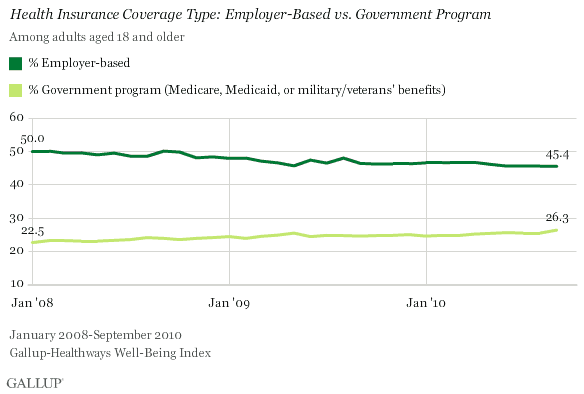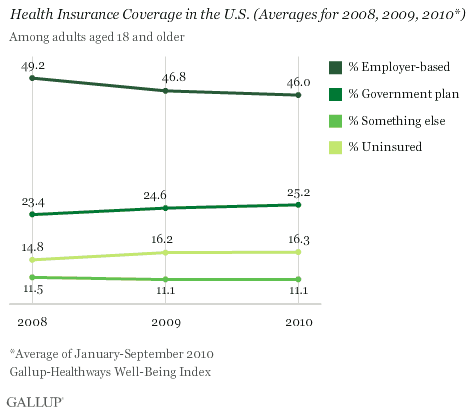WASHINGTON, D.C. -- More American adults reported having government healthcare -- Medicare, Medicaid, or military/veterans' benefits -- in September (26.3%) than in any previous month since Gallup and Healthways began tracking it in January 2008, at which time the figure stood at 22.5%.

The increase in government insurance partially offsets the decline in employer-based insurance seen since January 2008 -- a decline that started in the fall of 2008 as the financial crisis exploded and large-scale layoffs began. The 45.4% of adults who reported they had employer-based coverage in September is statistically unchanged from the summer months, but down from earlier this year, and significantly lower than the 50% who said the same in January 2008.
The percentage of Americans without health insurance was 16.1% last month, about on par with the 16.6% in August, but still higher than the 14.8% in January 2008.
Gallup asks Americans about their healthcare coverage daily as part of the Gallup-Healthways Well-Being Index and typically reports monthly and annual findings. The monthly data for September are based on interviews with more than 30,000 Americans.
Looking at the data more broadly, the year-to-date average for employer-based coverage is 46% and trending down compared with 2009 and 2008, while the figure for government healthcare is 25.2% and trending up.

President Obama signed the Affordable Care Act into law a little more than six months ago, and various parts of the bill have been trickling into action since. The Gallup trends indicate that the policy changes that have been implemented thus far have yet to significantly alter the pattern of healthcare coverage among Americans.
But several provisions of the new healthcare law that will have a direct impact on Americans' health coverage were initiated at the end of September and include: allowing children up to age 26 to remain on their parents' plan, outlawing insurers from canceling a person's coverage if they get sick, and eliminating lifetime dollar limits on coverage. These changes, along with several other provisions that have already been implemented, will over time affect how many Americans get their health insurance from the government or their employer, how many buy it on their own, and how many will continue to go uninsured. The extent to which the coverage distribution will change is yet to be determined and Gallup will continue to monitor and report on health insurance in the United States.
About the Gallup-Healthways Well-Being Index
The Gallup-Healthways Well-Being Index tracks U.S. well-being and provides best-in-class solutions for a healthier world. To learn more, please visit well-beingindex.com.
Results are based on telephone interviews conducted as part of the Gallup-Healthways Well-Being Index survey Sept. 1-30, 2010, with a random sample of 30,248 adults, aged 18 and older, living in all 50 U.S. states and the District of Columbia, selected using random-digit-dial sampling.
For results based on the total sample of national adults, one can say with 95% confidence that the maximum margin of sampling error is ±1 percentage point.
Interviews are conducted with respondents on landline telephones and cellular phones, with interviews conducted in Spanish for respondents who are primarily Spanish-speaking. Each daily sample includes a minimum quota of 150 cell phone respondents and 850 landline respondents, with additional minimum quotas among landline respondents for gender within region. Landline respondents are chosen at random within each household on the basis of which member had the most recent birthday.
Samples are weighted by gender, age, race, Hispanic ethnicity, education, region, adults in the household, cell phone-only status, cell phone-mostly status, and phone lines. Demographic weighting targets are based on the March 2009 Current Population Survey figures for the aged 18 and older non-institutionalized population living in U.S. telephone households. All reported margins of sampling error include the computed design effects for weighting and sample design.
In addition to sampling error, question wording and practical difficulties in conducting surveys can introduce error or bias into the findings of public opinion polls.
For more details on Gallup's polling methodology, visit https://www.gallup.com/.
